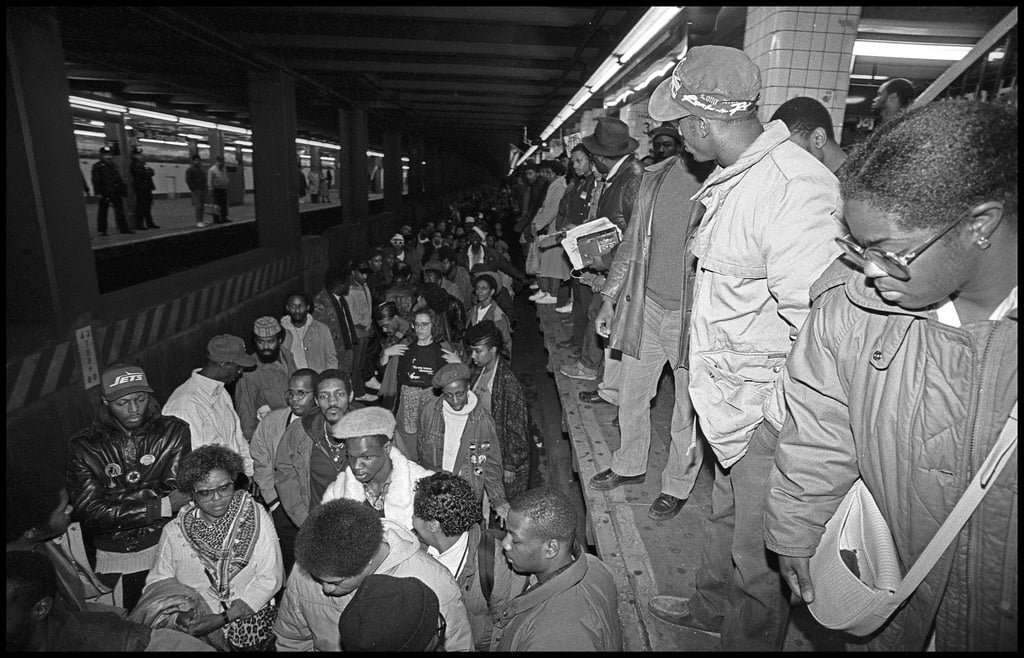 Protestors walk the tracks, stopping subway cars at the Jay Street-Borough Hall Station, in the Day of Outrage demonstration after the Howard Beach racial killing verdict on December 21, 1987.
Ricky Flores, 1987.
Protestors walk the tracks, stopping subway cars at the Jay Street-Borough Hall Station, in the Day of Outrage demonstration after the Howard Beach racial killing verdict on December 21, 1987.
Ricky Flores, 1987.
New York City has a long history of protesting injustice and doing so vocally. The election of Donald Trump. Black Lives Matter. Occupy Wall Street. These were just some of the major demonstrations to overwhelm city blocks in the last decade. Thus, in a push to bridge generations, the Bronx Documentary Center has opened a photo exhibit that spotlights various protests across a pivotal stretch of time, from 1980 to 2000. Fittingly titled Whose Streets? Our Streets!, the creative undertaking collects work from 40 photographers who captured moments of civil tumult throughout the five boroughs: from die-ins and transit disruptions to protestors standing face-to-face with militarized police.
The FADER recently spoke with three of the exhibit’s featured photographers — Ricky Flores, Clayton Patterson, and Lisa Kahane — about the importance of context, the changing barriers, and how new image-taking technologies have shifted the landscape of documentation.
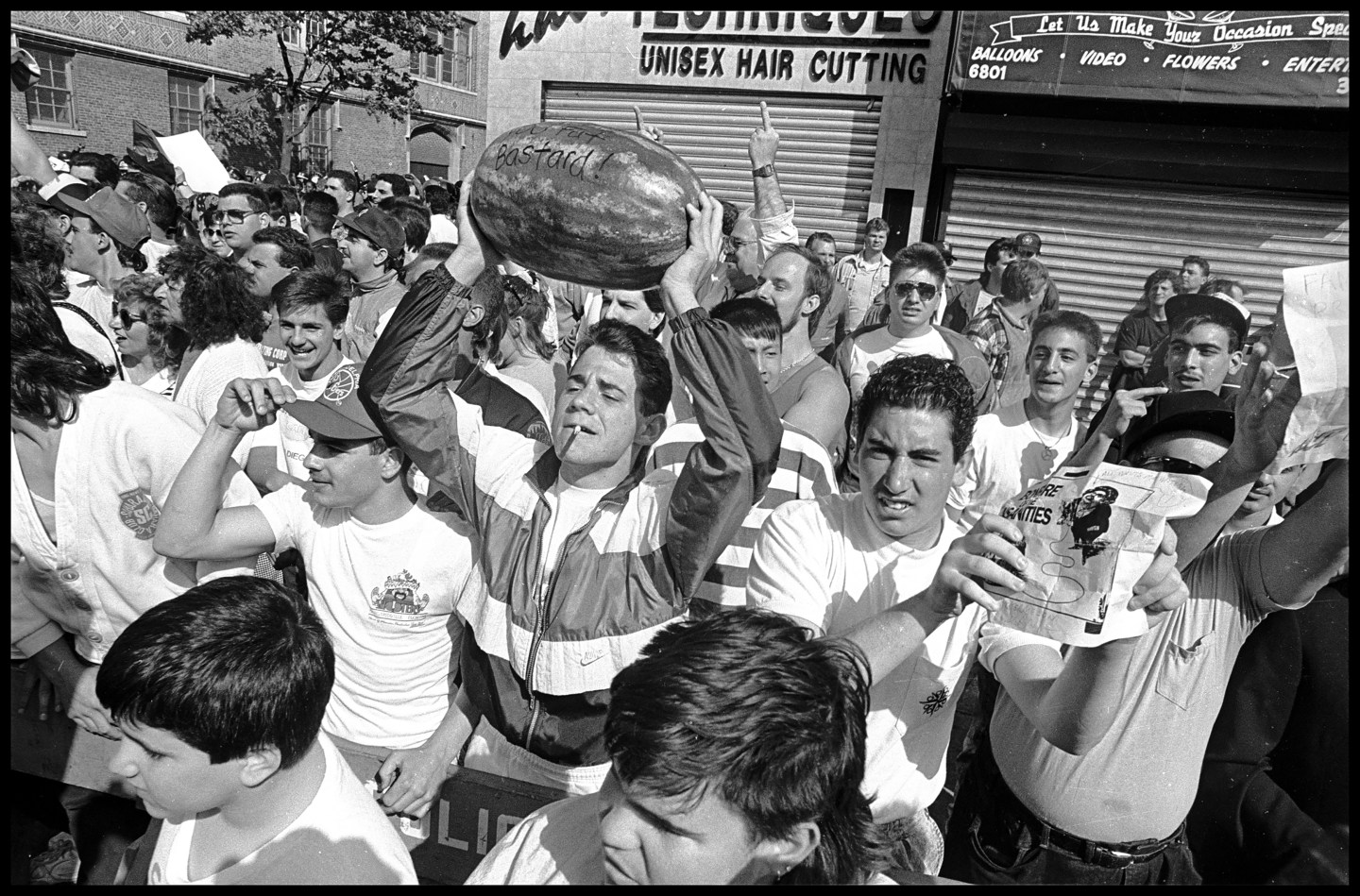 Counterdemonstrators in the mostly Italian-American neighborhood of Bensonhurst jeer at African-American marchers led by Rev. Al Sharpton after the acquittal of Keith Mondello on the charge of manslaughter in the death of Yusef Hawkins.
Ricky Flores, 1990.
Counterdemonstrators in the mostly Italian-American neighborhood of Bensonhurst jeer at African-American marchers led by Rev. Al Sharpton after the acquittal of Keith Mondello on the charge of manslaughter in the death of Yusef Hawkins.
Ricky Flores, 1990.
RICKY FLORES: I don't see progressive photojournalists in the street working in concert to document all aspects of social movements within their cities and communities anymore. We all used to work together in order to make sure that work in the community got out there. We recognized no one was gonna document these movements the way we were. We had a vested interest in making sure these movements were properly shown to the world, in keeping a record, and how they connect to one another. People tend to look at a social movement as a single issue, but they are intricately linked.
Some people are into shooting protest porn. They don’t draw any connections or relate it to other movements and just capture the moment. This creates a fragmented view of history. It’s easy to photograph a riot or a homeless person. But if you can’t make the connection to why these events are happening, you can’t change the conditions. We have to guard against that.
The issues today are very similar; almost a repetition. We’re still dealing with police brutality, homophobia, anti-semitism, and Islamophobia. The only difference is that now more people are documenting themselves. The common person walking down the street will see something and actually document what’s going down. As much as we’d like to believe that we’ve progressed, we’ve gone backwards in some ways. It’s clear that the same issues are still prevalent today.
Today there are so many more tools available and they’re cheaper. You could do it all on your phone. It’s good and bad. Accomplished photographers have gone into combat with their iPhone. But I’ve also seen kids filming a fire and screaming, “Worldstar! Worldstar!” It’s fascinating though, seeing the world through the eyes of everyday people. It’s a clearer picture that the whole world can potentially see. Look at Philando Castile. And these events get strung together by others. It adds to the narrative, but is meaningless without context. Photojournalists go beyond the reaction, go and talk to the victim’s families and add to their voice, and investigate the police involved.
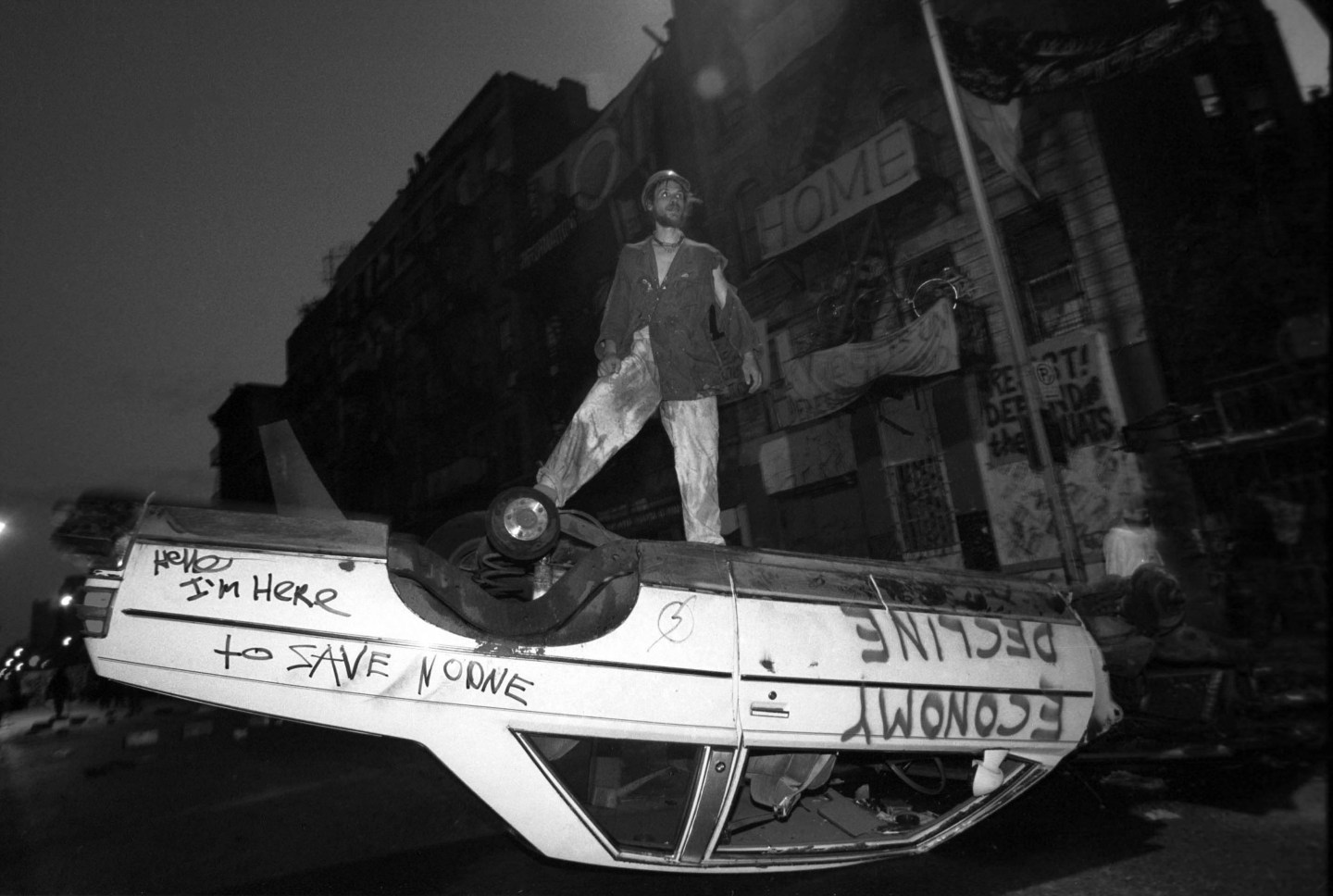 Squatters attempt to defend their building on East 13th Street from an expected attack by the police by blocking the street with overturned cars and trash.
Andrew Lichtenstein, 1995.
Squatters attempt to defend their building on East 13th Street from an expected attack by the police by blocking the street with overturned cars and trash.
Andrew Lichtenstein, 1995.
CLAYTON PATTERSON: There’s a lot of great photography here and I’m hoping someone will take it to a larger institution. You can see and feel the importance of doing this kind of work. And I think you can see it was done by a variety of people. It should travel or be in a museum, but we don't really have an institution in New York that it fits right now. The money has killed art in New York and the muse has moved on.
There used to be more of a collective consciousness of New York. With gentrification we became more international and corporate and tourist, so we lost a lot of identity of New York itself. We lost neighborhood character and its characters, and the media is no different. The media turned into a corporate structure with little connection to reality. We live in a Kardashian world.
The internet has shattered the diamond. Each of the different pieces has its own following. In my time, you had people like the Rolling Stones that dominated everything. Now you’ve got hundreds of categories. It’s broken apart any kind of dominance, and now you have this pool of social media and blogs that people draw from. Each thing is its own parcel of land. This generalizes things and puts power into a smaller group of hands. Say someone wanted to start a movement against Trump, there’s so many fractured pieces making it very difficult.
But things can happen that generate great change. When I made the videotape of the Tompkins Square riots in 1988, that was the first time a commercially available handheld camera had been used like that. I changed the model because I was just some guy in the street with a camera. It looked like a toy so the cops were like, “Who gives a shit?” But I also resisted and went to court and made a lot of noise. Now go ahead and look at the shooting of Oscar Grant caught on a cell phone. So those moments do happen.
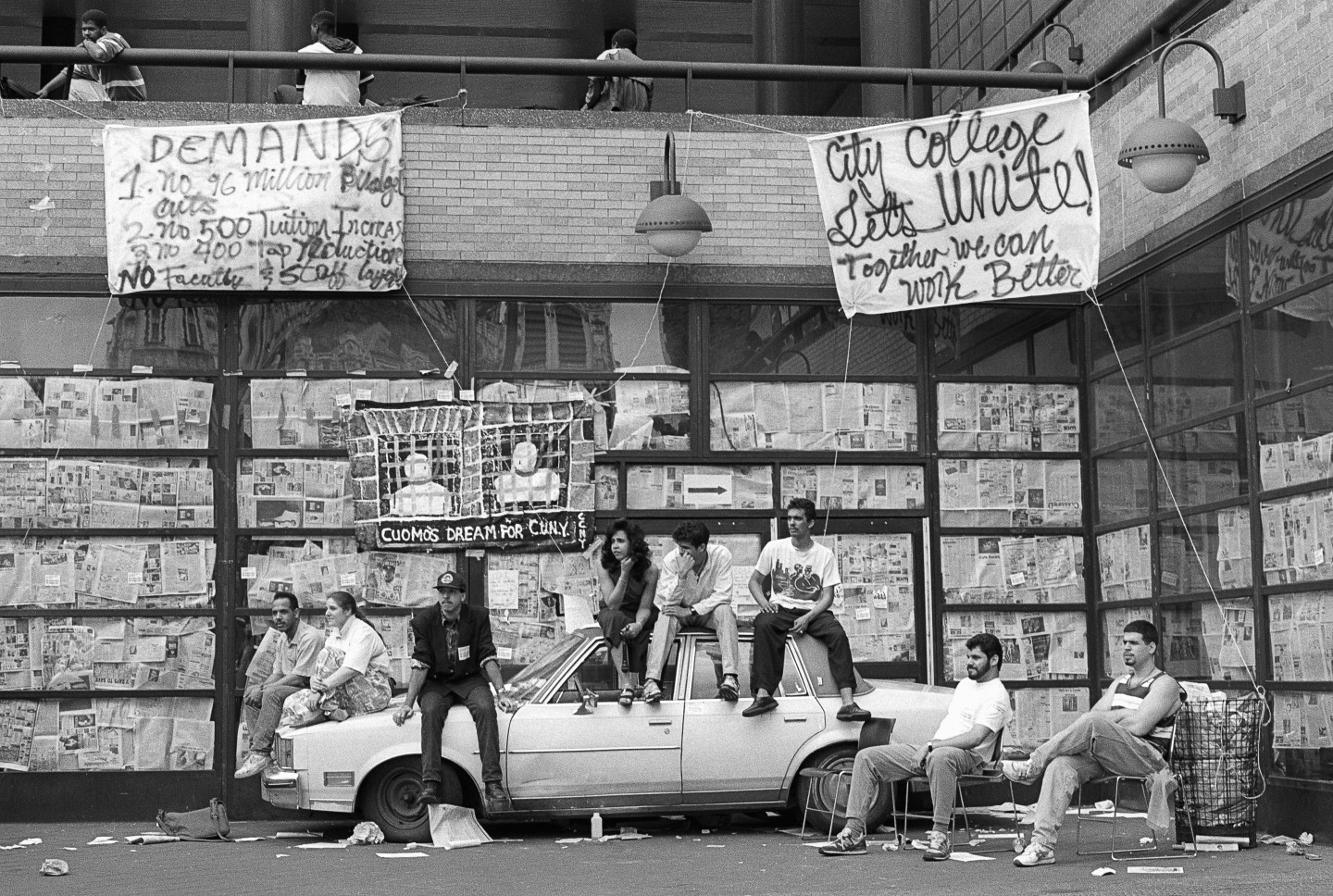 Students sit on a car parked outside an occupied building on the City College campus during the CUNY student strike protesting proposed tuition increases and budget cuts.
Lisa Kahane, 1991.
Students sit on a car parked outside an occupied building on the City College campus during the CUNY student strike protesting proposed tuition increases and budget cuts.
Lisa Kahane, 1991.
LISA KAHANE: In my time, protest photos only made it into mainstream media if there was blood, arrests, or critical mass. But a lot of us went out and photographed it just because it was history, regardless of whether they saw the light of day. Now people can just put it on social media. It’s important to. Wherever your heart leads you, shoot it and archive it. I earned money as a studio photographer, the work I did in the streets was personal work that I believed in. I got stuff published, but that didn't concern me. The hardest thing is to decide what will be most important down the road.
Looking at the past offers hindsight on what was done best or could've been done differently. Young people always tell me they wish they lived through the '60s. But now everyone's getting a taste of what it was like. It wasn’t a lot of fun. It was really upsetting. When you protest, which is very necessary, there are consequences, and you really have to think about how to manage that in your personal life and the political life of the country.
I draw a line between vandalism and protest. I shy away from bloodshed. You can’t be antiwar and go knock someone out. When there’s a big group of people, there’s something else going on that’s not rational. That’s just my opinion. Some people might tell you otherwise, because sometimes you can’t get the attention you need. Sometimes you can’t help it and the anger overflows with nowhere else to go. I was here when Martin Luther King Jr. was killed and Harlem burned. You have to understand the causes of these things.
Emotion is one of the things that photography is great for. You can capture it in a way that’s so difficult in words. Violence happens and it’s important to document it. But you have to think responsibly about what you’re doing with your imagery. For example, women are so often portrayed as victims in the media, so in order to change that, there must be a new genre created so people will get used to looking at women in a different way. That’s true in a lot of ways.
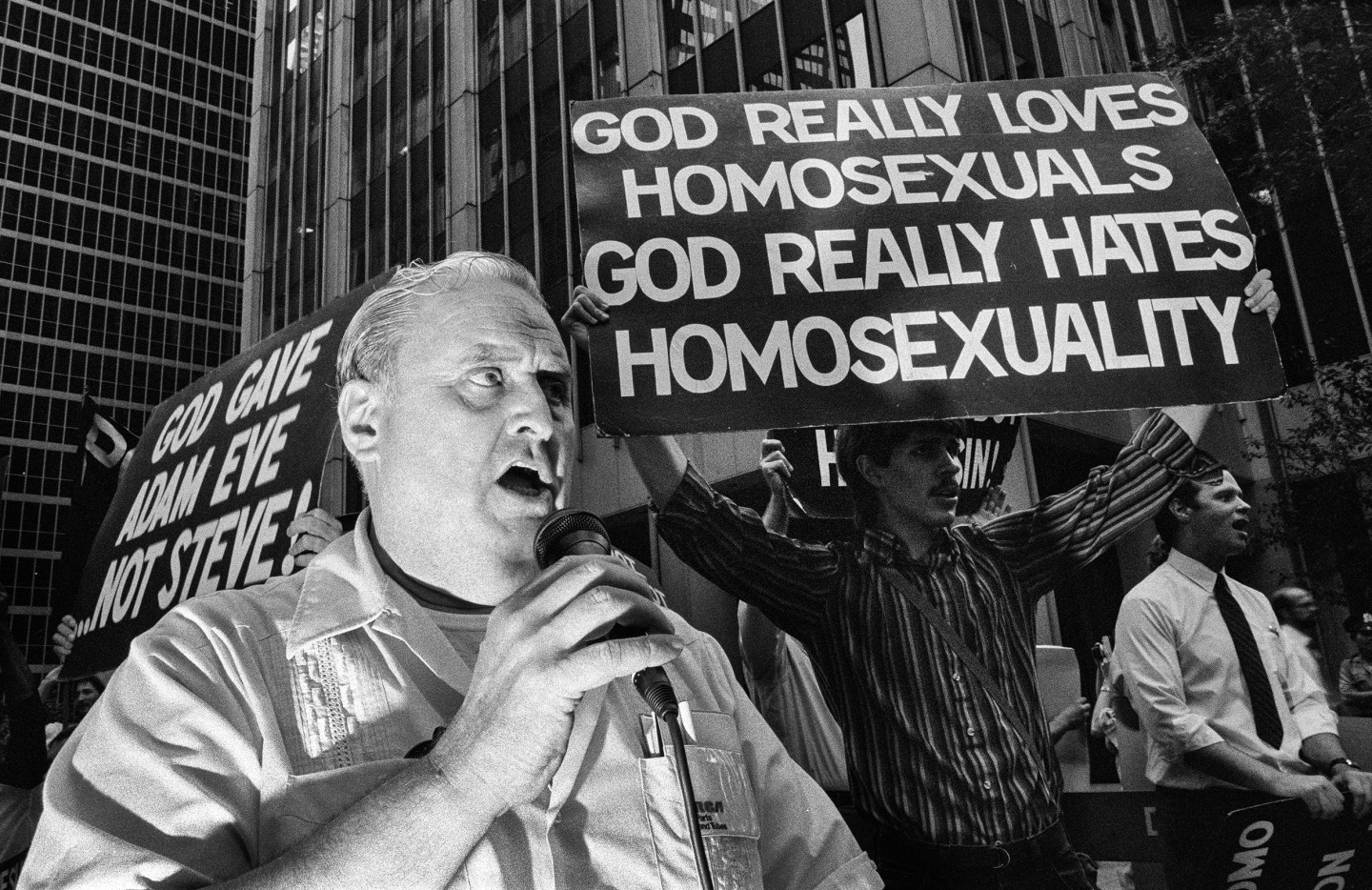 Anti-gay rights demonstration on 6th Avenue.
Richard Sandler, 1992.
Anti-gay rights demonstration on 6th Avenue.
Richard Sandler, 1992.